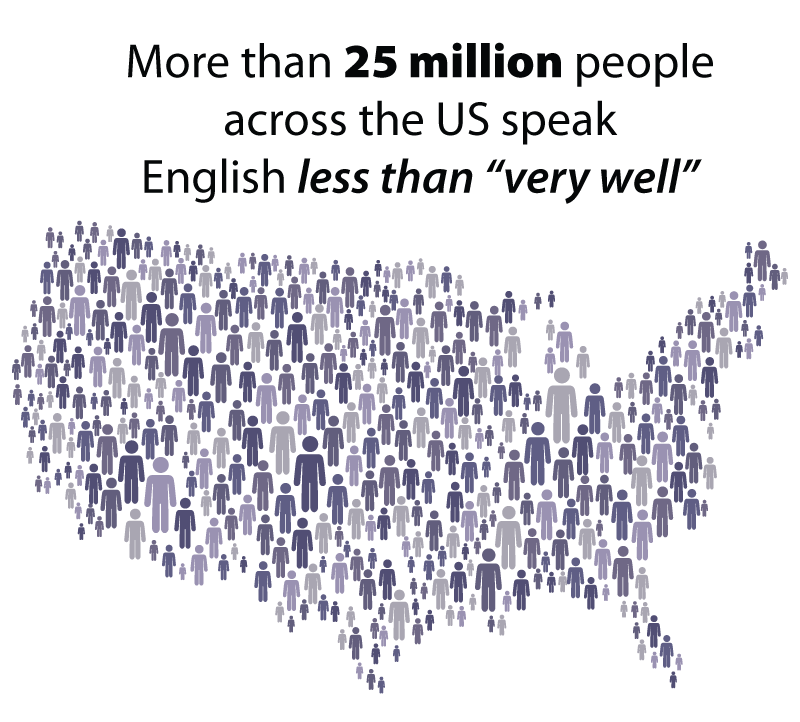How to communicate with your LEP customers to provide excellent customer service

What’s your plan for handling calls or providing information to limited-English proficient (LEP) clients and customers who speak a language other than English?
We want to help you empower your employees to confidently guide non-English speaking callers to the resources they need from your company. We gathered data about the 25 million LEP people across the US, including their expectations for multilingual customer support. From there, we’ve outlined potential solutions businesses can implement to offer better language services, including how to select the right provider for your needs.
When a non-English speaking client or customer needs assistance or information but cannot can’t communicate their needs to your representatives or understand the materials, it can cause several issues:
Language barriers hinder clear and effective communication, often leaving employees unable to resolve the customer’s problem.
When employees can’t speak the same language as the customer, providing fantastic customer service is nearly impossible.
Your written materials should be translated and localized to avoid providing clients with written materials that don’t communicate your message properly.
Customers with unresolved issues most likely won’t purchase from your company again, and they may even tell their friends and family about their negative experience.

Your company may not recognize the limited-English proficient (LEP) population’s impact on revenue. Consider these stats:

• Note: These numbers don’t include global audiences you may try to reach

In addition, 40% will never buy from websites in other languages. (CSA Research)

However, only 19% of the surveyed customer contact centers offer support in multiple languages. (ICMI)
In addition, a survey by Intercom resulted in the following data:

It’s safe to say offering customer service and written communication in multiple languages can help you connect better with non-English-speaking consumers. So how can you implement better language services? Let’s review potential solutions in step 3.
Some companies hire bilingual employees to help them communicate with limited-English proficient (LEP) customers. While it can be convenient to have multilingual employees, you’ll need to consider how job duties may change, how you’ll measure language and interpreting skills, and more before committing to this solution.
You’ll also need to examine whether the benefits of hiring bilingual employees outweigh any disadvantages.
According to survey results from Intercom, 85% of support managers say it’s challenging to find reps who speak more than one language.
Here’s a helpful list of questions organizations should answer before hiring bilingual employees.
CyraCom offers a Language Proficiency Assessment in more than 45 languages, which is an easy way to determine how well someone speaks their second language. The assessment uses the Interagency Language Roundtable (ILR) standards, a US federal organization that coordinates and shares information about language-related activities. We also offer an Interpreter Skills Assessment, which is available in more than 20 languages.

Businesses can improve customer service performance metrics by working with a language services provider (LSP). Investing in phone interpretation performed by qualified professionals saves you the hassle of recruiting, hiring, assessing, and retaining bilingual employees. Plus, you can:

Hiring bilingual employees can help you serve customers who speak the same language, but how will you help those who speak less-common languages? Working with an LSP gives you access to interpreters as needed, meaning you can reduce fixed costs.

Forbes reports that poor customer service costs businesses more than $75 billion a year and that 67% of customers have become “serial switchers”—customers willing to switch brands because of a poor customer experience. For a company that provides good service, 66% of customers would be more loyal, 65% would be willing to recommend the company to others, and 48% would spend more money.
Retaining existing customers can be easier when you provide exceptional service in customers’ preferred language. 75% of CSA Research survey respondents said they’re more likely to purchase the same brand again if customer care is in their language.

In an ICMI survey, 79% of contact centers have customers who aren’t native speakers of their primary languages. Unclear communication can automatically reduce your employees’ ability to offer support and resolve customers’ issues. Implementing language services can help you improve first-call resolution (FCR), average handling time (AHT), and customer satisfaction scores (CSAT).
In addition to interpretation, you may want to consider translating and localizing written materials such as website content, informative brochures, video captioning, and more. To follow OSHA guidelines, translating safety materials can help you stay compliant.
According to CSA Research:
Professional human translators localize your text to help ensure clear communication. They convert your text into another language using your intended meaning rather than simply translating it word-for-word. Working with an LSP for document or website translation can take longer than using an employee or risky machine translation, but you can better avoid alienating potential customers.
Plus, CSA’s Article “Fortune 500 Companies that Invest in Translation Report Higher Revenue” notes that expanding translation budgets made businesses 1.5 times more likely to report an overall revenue increase.

If you choose to use qualified, professional interpreters and translators, you’ll need to select the right LSP for your needs. Don’t worry—we’ve got the information you need to make your selection.
With many options available for interpretation and translation services, how do you choose the best one to work with? Vet potential LSPs by asking questions about the following topics:
Whether you have a question, need to resolve an issue, or want to review your data, you'll need to know who to contact. Your LSP should supply an experienced, knowledgeable primary contact that simplifies access to the larger support team. Choose an LSP that assigns a dedicated account manager responsible for nurturing the partnership and ensuring all your services work harmoniously.
Resource: How CyraCom provides the tools and support services you need
Quality phone and video interpretation require three key components:
Translation shouldn't start fresh when you need documents, videos, training courses, or websites in another language. Choose a partner that tracks past projects and doesn't charge you twice to translate the same words, paragraphs, or excerpts regularly used in written communications.
Beyond saving time and budget, ask LSPs how they secure data and provide quality assurance. For example, CyraCom not only translates text, but localizes so that your message sounds as if it were originally written in the target language. In addition to a human translator, our clients’ projects are reviewed by a second linguist to verify accuracy.
Resource: Video: CyraCom’s Translation & Localization Services

If you’re required to hire vendors through a Request for Proposal (RFP) process, check out this article for additional information.
Here are several best practices you can implement for handling non-English calls:
Businesses must keep employees informed about process changes. Start by explaining any changes the customers will encounter, such as new automated options for callers to speak with a representative in a language other than English. Next, outline the steps employees will need to follow. You may decide to train and encourage employees to learn the phrase, "Please wait for one moment" in your top languages to help customers understand they're connecting with an interpreter or bilingual employee.
Employees should have clear and concise instructions readily available to keep their average handling time as low as possible. Consider using digital and printed reference materials for easier access to the correct procedure sequence. Include any phone, account, and password information the employee will need to reach an interpreter.
If your employees haven’t worked with interpreters before, share these helpful tips and tricks:


CyraCom is a leading language services provider with over 25 years’ experience helping businesses like yours connect with new customers. We offer free consultations – contact us at [email protected] today to learn how language services can help you grow your business.
Whether you’re expanding to reach new, multilingual audiences or need better support for the LEP customers you currently have, you need the ability to communicate clearly and effectively.
CyraCom is here to help!

About CyraCom
In business for over 30 years, CyraCom is a language services leader that provides interpretation and translation services to thousands of organizations across the US and worldwide.
Sales Inquiries
New Client Signup &
Current Client Support
CyraCom Careers
Corporate Office
2650 E Elvira Rd, Suite 132
Tucson, AZ 85756
Sign in to your account